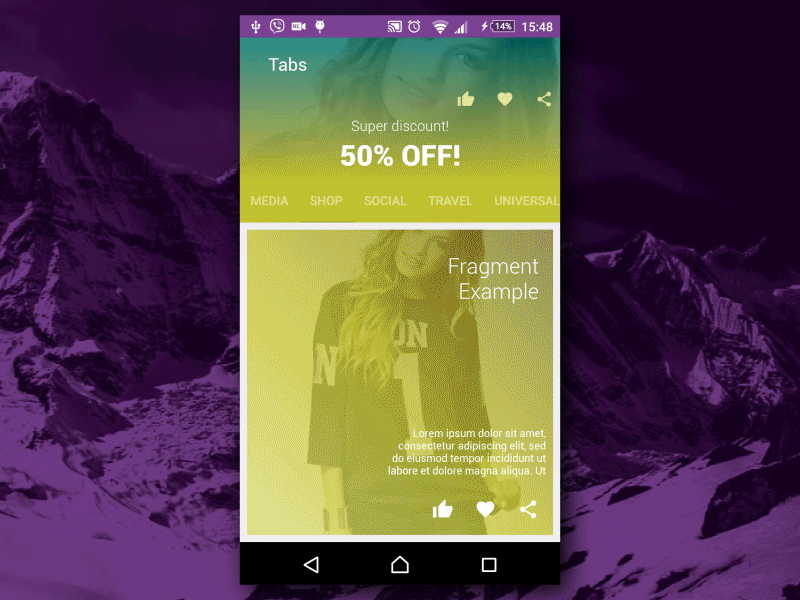
- #Template design theme android studio how to
- #Template design theme android studio update
- #Template design theme android studio android
- #Template design theme android studio code
This theme, along with many others, is part of the Material Design Components library.
#Template design theme android studio android
Here are the default contents of the themes.xml file: apps created using the latest version of Android Studio use a theme called. You can find the theme file for your app by navigating to app > res > values > themes > themes.xml. When a style is applied to an activity or application, it becomes a theme. Android allows you to apply styles to entire activities and applications too. Creating ThemesĪll this while, we've only been applying styles to views that are inside an activity. Take a look at the source file to see the rules applied when different styles are used. For example, you can use the textAppearance attribute and set its value to in order to apply a bunch of predefined typography styles. You can also use a lot of other predefined styles with your views. Most developers use the implicit syntax while extending their own styles, and the explicit syntax while extending platform styles.
#Template design theme android studio how to
We will learn how to do that in the next section.Īpplying derived styles is no different from applying normal ones.

This makes it easier to switch the styling of the whole app at once by switching themes. You should note that we have not supplied any hardcoded colors or direct resource references when specifying the value of the textColor attribute.

#Template design theme android studio code
Here's a code snippet that defines styles called PrimaryText and SecondaryText. It involves using a parent attribute whose value is set to the name of the parent style. The second syntax for creating a derived style is usually referred to as the explicit syntax. In addition to those, they have the android:textColor property. For example, here's how you create two derived styles, called PrimaryText and SecondaryText, using LeftAlignedView as the parent style: Īs you might have guessed, both LeftAlignedView.PrimaryText and LeftAlignedView.SecondaryText have all the properties of LeftAlignedText. The first syntax is often called the implicit syntax, and it uses a dot notation. There are two different syntaxes you can follow while extending a style. In other words, it allows you to extend existing styles. Extending StylesĪndroid allows you to create styles that use other styles as a foundation.
#Template design theme android studio update
You could simply make the change in a single place, and the layout would update accordingly, as shown below: 2. Now, let's say you want to change the layout_marginStart value for both the TextView elements to 20dp. For example, here's how you would apply LeftAlignedView to the second TextView: Once a style has been created, you can apply it to any view. You can take a look at the definition of the style by opening res/values/styles.xml. The TextView now has a style attribute that points to the LeftAlignedView style. When you press OK, you'll see that the code for the first view has changed. Let the name be LeftAlignedView and select all the attributes except layout_marginTop. You will now see a dialog where you can give a name to the style and select the attributes that should be included in it. You can do so by right-clicking on the TextView and selecting Refactor > Extract > Style. One way to avoid the duplication and make the styling of these Views easier is to define a separate style that holds the values of all these common attributes. The situation would get worse if there were more such elements.

You will have to make changes in two different places for it to work.

Let's say you wanted to change the layout_marginStart value for these TextView elements. Īs you can see in the above code, properties such as layout_width, layout_height, and layout_marginStart are explicitly included in the definition of each view, and they have the same value. Therefore, let's start by creating a new empty activity and adding two TextView elements to its layout XML file. Styles are obviously applied to UI components. You'll also learn how styles and themes are different from each other and how to use them properly. In this tutorial, you'll learn how to create custom styles and themes for your Android apps. If you are familiar with web development, the first approach is akin to using inline CSS styles, and the second approach is akin to using stylesheets. The second approach involves creating and using custom styles and themes. This approach is feasible only if you are working on a simple app that has a small number of views and activities. The first approach involves directly modifying the properties of views in layout XML files. There are two approaches to modifying the look of Android apps. If you find that hard to believe, I suggest you take a quick look at the apps in the Top Charts section of Google Play. On Google Play, which hosts well over a million apps today, looks are just as important as functionality, if not more. Functionality alone, however, is rarely enough. As Android developers, we tend to focus primarily on the functionality of our apps.


 0 kommentar(er)
0 kommentar(er)
